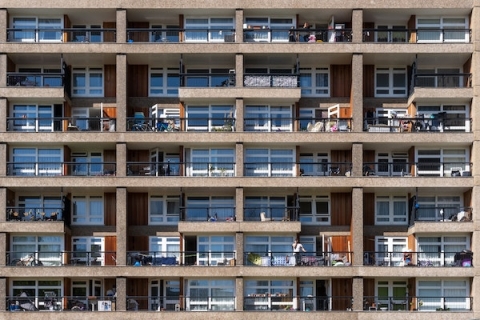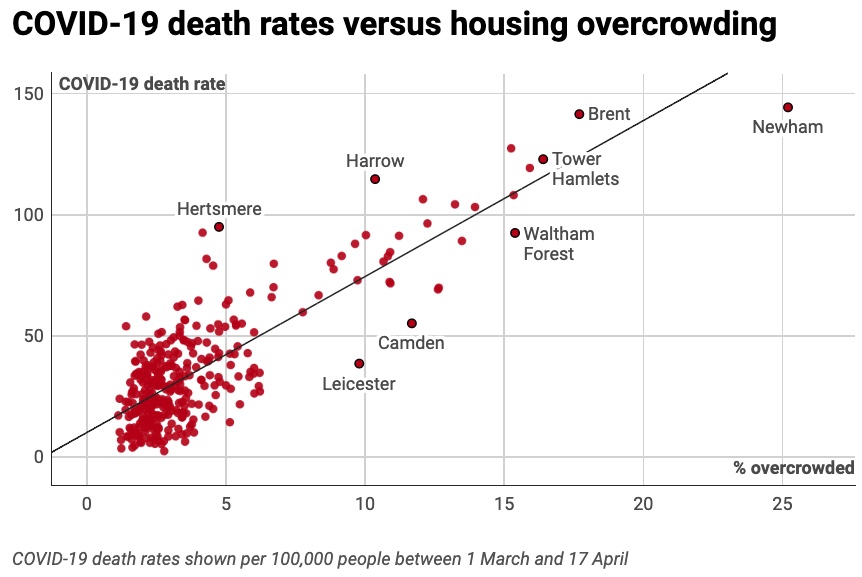

What is the ‘housing crisis’? What are its effects? How is it producing uneven experiences of COVID-19?
5 min read
In May 2020, lead member for housing services at Newham Council, John Gray, branded coronavirus 'a housing disease'.
Newham, a borough in East London, has suffered one of the highest COVID-19 mortality rates in the country, and in May 2020 it had the highest death rate nationally with 144.3 people dying per 100,000 population. Importantly, Newham also suffers the highest level of housing overcrowding in the country, with over 25% of households affected. Furthermore, the number of households in temporary accommodation in Newham sits at 46.1%, once again the highest rate in Britain.
Increasingly, the UK finds itself facing a housing crisis that makes experiences such as overcrowding and impermanence common features of everyday life. Now, COVID-19 is demonstrating with devastating effect what many have been arguing for years: that inadequate housing makes individuals and families more vulnerable to health issues and premature death.
Housing in crisis: how did we get here?
Overcrowded, inadequate and insecure housing are painful symptoms of a UK wide housing gap, the effects of which cut across multiple generations and socio-economic groups just as they impact vulnerable populations the most.
The National Housing Federation estimates that 8.4 million people in England alone are living in unaffordable or unsuitable accommodation, with 3.6 million living in overcrowded homes and 1.4 million in poor quality homes. The BBC’s Housing Briefing estimates that 1.2 million fewer homes have been built in the UK than required by the population, and that if current building rates stay the same it will take 15 years to close this gap.
Largely, the UK’s housing crisis is founded on a critical gulf between supply and demand. Despite ever-increasing numbers of households living in substandard accommodation and spending months and/or years on council housing waiting lists, fewer homes are being built now than during many periods in recent history.
For Stephens and Stephenson, the housing crisis must be understood in the wider context of austerity, and as part of a 'radical reorientation' of policy since 2010, through which the coalition government and, thereafter, the majority Conservative government have increased barriers to affordable housing for low income groups and withdrawn the sorts of safety measures put in place to protect them.
As Lund elaborates, between 2010 and 2015 central government funding for social housing was reduced from £6.8 billion to £2 billion, under a quarter of previous input. In addition, between 2009/10 and 2015/16, council house rents (after Housing Benefit) increased by 37.7% and housing association rents by 38.6%, as the government under Prime Minister David Cameron sought to raise all social rents in-line with the private market.
Aside from these more recent trends in housing policy, today’s UK housing crisis also has older roots. Under the 1980 Housing Act, then Prime Minister Margaret Thatcher’s government oversaw the selling off of over a million council houses between 1980-1987 alone. The scheme which made this possible, the ‘Right to Buy’ scheme, enabled council tenants to buy their homes at a significant discount and made home ownership a real possibility for working class individuals, families and communities. However, just as homes were being sold off, public funding for housing construction decreased dramatically, and the assumption that the private sector would pick up the slack has failed to come to fruition in the decades since.
All of this has led to a situation today in which social housing stocks in the UK are far lower than the level of need, just as a decade of sharp housing inflation continues to make the private housing market increasingly inaccessible.
Housing and health: making links across crises
In claiming coronavirus to be ‘a housing disease’, John Gray was making a crucial connection between the in/adequacy of housing provisions in particular UK communities and the prevalence and virulence of COVID-19.
Analysis by Inside Housing evidenced that out of the top 20 local authority areas in which the virus has claimed the most lives per 100,000 people, 14 also suffer the highest percentage of households with fewer bedrooms than deemed essential according to the government’s own housing standards.
The graph below, from Inside Housing, shows just how stark this correlation was during the first wave of the crisis:

Sources: Chart: Nathaniel Barker, Inside Housing; Data: ONS
This reality is not only true of the British context. Research in the United States has also demonstrated that across US counties, for ‘each 5% increase in households with poor housing conditions, there was a 50% higher risk of COVID-19 incidence and a 42% higher risk of COVID-19 mortality’.
The link between housing and public health is clear, and it is also important to recognise that inadequate housing is a socio-economic issue – that is to say, it is a crisis that impacts the poorest communities. Research from the Office for National Statistics has also evidenced that socio-economic deprivation leads to far higher rates of fatality from COVID-19. This is also interesting in light of the disproportionate number of BAME (‘Black and minority ethnic’) coronavirus cases and deaths, particularly as the latest research from the Social Metrics Commission shows that almost half of BAME households in the UK are living in poverty. These are also, then, households most likely to be suffering overcrowding and other forms of inadequate housing.
Coronavirus: a ‘housing disease’?
What is becoming increasingly clear, is that the impact of COVID-19 upon individuals and communities depends significantly on the circumstances they were already experiencing at the point of the pandemic.
As a virus, COVID-19 moves across uneven contexts, and lays bare the structural inequalities that make certain lives more vulnerable to illness and premature death. Here, the links between housing and public health are forced into view, as the likelihood of an individual surviving the pandemic is directly correlated to the quality of the home they live in.
This post is part of a series titled Homeless Migrants and COVID-19: Mapping the layers of crisis.
This post reflects the views of the University of Portsmouth research team only, and not those of our project collaborators, the homelessness charity St Mungo's.
Author: Dr Charlotte Sanders.
